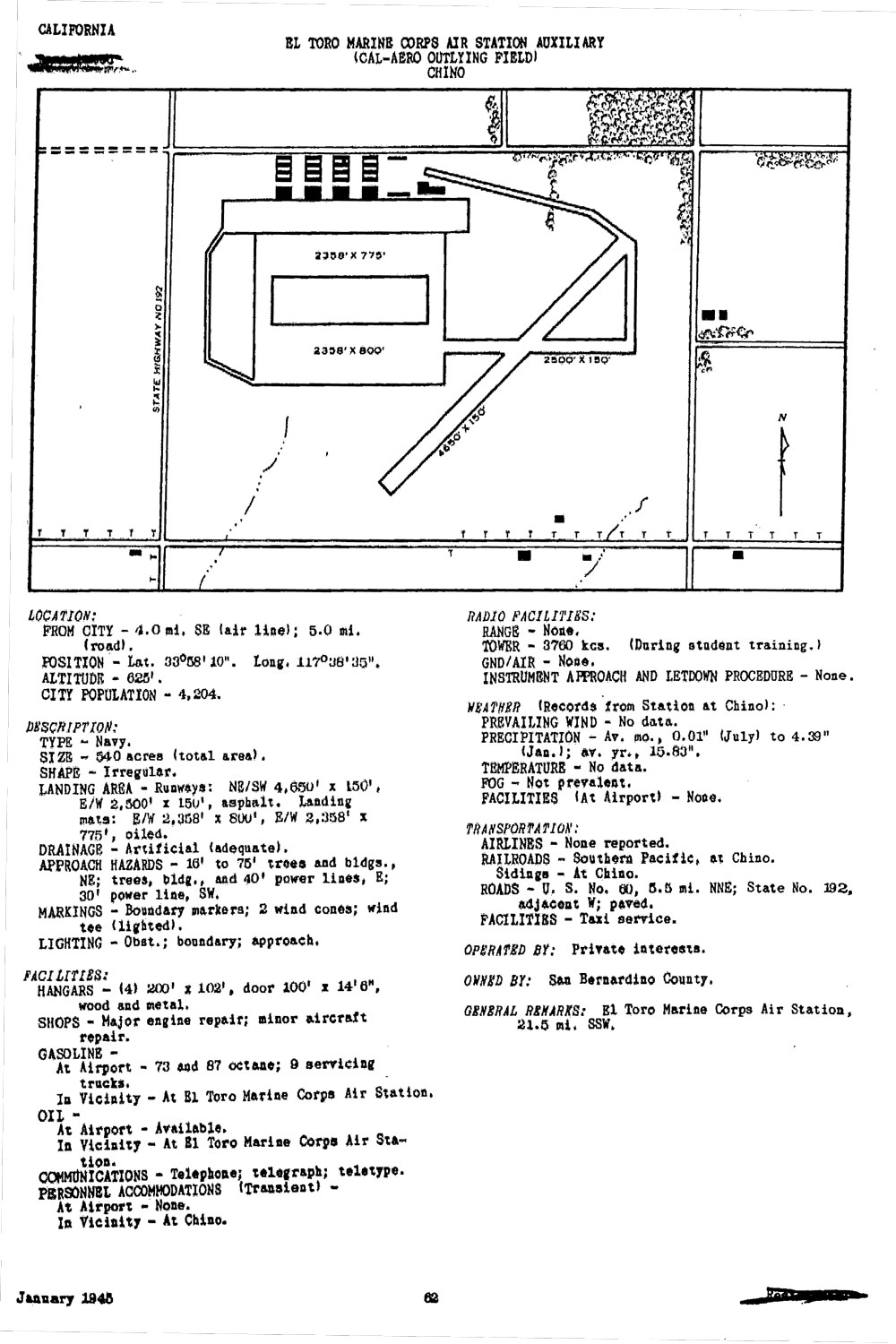
The two training periods consisted of flight instruction and ground school. To support this training, barracks and facilities were provided by the civilian-owned Academy to accommodate up to 500 men. After training at Cal-Aero, cadets were sent to Kelly Field and Stockton Field for their advanced training. Not all cadets trained at the Academy for the entire twenty week period. Records show that some cadets went to the Victorville Army Flying School for their basic training.
Two parallel east-west landing strips were located on the CalAero Academy. The government extended these runways 2520 feet onto the property that War Department acquired by fee. A new, 4625 foot northeast-southwest runway was also constructed. Approximately two thirds of runway construction took place on government owned land, the remainder took place on the Cal-Aero Academy property. Taxiways, a storm drainage system, and fencing were constructed by the government on the entire site. A total of 13 concrete airplane protective dispersal revetments were constructed: eight were located on government-owned land, and five were located on the Academy. Three underground storage tanks were installed on the Cal-Aero Academy in 1942. Two were 10,000 gallon tanks, one was a 1,000 gallon tank. All three tanks stored gasoline. A sewage treatment plant was constructed on government-owned land.
On 1 July 1945, the Defense Plant Corporation was dissolved and its functions transferred to it parent corporation, the Reconstruction Finance Corporation. Thus, the RFC assumed the DPC lease with the County of San Bernardino. The War Department retained control of its purchased property. The entire 656.4 acre site was declared surplus on 22 April 1946. Pilot training operations on the site were concluded in 1946. Subsequent to training operations, the entire site was utilized by the Reconstruction Finance Corporation Sales and Storage Depot No. 8 to store surplus aircraft. During this period, the Pacific Aeromotive Company operated on the Cal-Aero Academy site, presumably under contract with the RFC, to melt down the aluminum components of these surplus aircraft for use in the manufacture of new civilian aircraft.
Before the components could be melted, however, all of the grease, oil, and fuel residue had to be removed. Therefore, the engines were reportedly immersed in open railroad cars filled with solvents in an area of the leased property shown on the attached site map. Reports suggest that solvents were drained from the railroad cars and onto the pavement, draining into a series of nearby retention ponds. Photographs and other evidence indicate that the smelting operations occurred on the property purchased by the War Department, in an area to the north of the northeast end of the NE-SW runway.
In 1949, the Reconstruction Finance Corporation terminated its lease with the County of San Bernardino for the leased Cal-Aero Academy property and the War Department transferred the land it had acquired by fee to the County of San Bernadino by quitclaim deed. Pacific Aeromotive Company reportedly continued its operations on the site until 1960. In 1968, American Electric, Inc., under contract with the u.S. Air Force, leased approximately 14.58 acres of the former Cal-Aero Academy property from the County of San Bernadino to produce napalm during the Vietnam War. This activity began sometime during 1968 and ended in the early 1970's. Following onsite activities, the napalm production facilities were abandoned, reportedly this included four underground storage tanks used for napalm storage. The entire site is now known as the Chino Airport, and it has continuously remained in the ownership of the County of San Bernardino.
Much of American industrial expansion during World War II was financed by the RFC through the Defense Plant Corporation. The War and Navy Departments, the Office of Production Management, the War Production Board and the Maritime Commission would request what they needed and in turn, the DPC would ensure that the plants were constructed, equipped and operated. Jones negotiated the contracts for the construction and operation of the plants and managed the corporation along with Emil Schram and Sam Husbands, both of whom were presidents of the organization during the war. Contract flying schools were also set up under the Defense Plat Corporation and overseen by the the Army Air Corps and later the Army Air Forces.
|
|
|
|
| 7 Dec 41 | Air Corps Training Detachment | |
| Army of the United States Station List | 1 June 43 |
|
|
|
|
